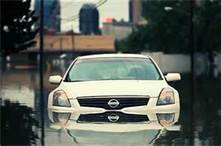Driver Education and Vehicle Technologies Can Ease Risks of Driving in El Niņo Rain Storms
 |
MyCarDoesWhat explains features that help in rainy conditions
ITASCA, IL and IOWA CITY, IA -- January 6, 2016: With El Niņo storms upon Southern California, the National Safety Council and the University of Iowa – creators of the MyCarDoesWhat campaign – share some tips for safe driving on rain-soaked and slippery roads.
Intense El Niņo-generated storms are slamming into the region and weather experts predict months of hard rain for California.
"Travel can be treacherous when roadway surfaces are compromised during rain storms," said Deborah A.P. Hersman, president and CEO of the National Safety Council. "The good news is that in-vehicle technologies can help drivers by providing advance warnings and preventing loss of control."
The MyCarDoesWhat campaign has the following tips for driving in rainy conditions:
SLOW DOWN – This is the golden rule of driving in the rain. Drivers need to recalibrate and adjust their driving in the rain. Drivers frequently underestimate how long it takes to brake and steer on slippery roads.
Stay toward the middle lanes – water tends to pool in outside lanes.
Do not use cruise control in heavy rains. Water pools and the car can suddenly surge when it loses traction.
Always look and steer where you want to go.
Keep a good following distance so that you can respond quickly to changes in traffic, (3 seconds is a good rule).
Never drive through moving water. If you can't see the ground, don't drive through it.
While the driver is always a vehicle's best safety feature, many safety technologies can help prevent or reduce the severity of rain-related crashes.
Technologies that can help you stay safe on the roads include:
Anti-lock braking systems (ABS): helps drivers steer in emergencies by restoring traction to tires. Contrary to popular belief, you should NOT pump the brakes when you have ABS—hold the brakes down firmly. They will buzz and vibrate when the ABS has activated.
Traction control: helps you accelerate without spinning out on slippery surfaces.
Electronic stability control: your car's computer helps sense when you may be losing control around a corner or curve by stabilizing your car when it begins to veer off your intended path.
Adaptive headlights: adapts to changing roadway conditions - such as curves - to help illuminate the roadway.
Avoid driving through deep water, it can cause serious damage to a modern vehicle's electrical system.
"Driving in intense rain requires much more focus on the conditions—and to adapt to an ever-changing, slippery environment," said Daniel McGehee, director of the Transportation and Vehicle Safety Program at the University of Iowa. "Technologies like anti-lock braking systems, traction control and electronic stability control, can make a big difference in driving in the rain, but it's important to remember to take it slow and avoid the roads when conditions are not ideal."
Research[i] shows most consumers are unsure about how many potentially life-saving vehicle safety technologies work, even those that have been standard for years like anti-lock braking systems. The MyCarDoesWhat campaign is designed to address that issue with videos and other consumer-friendly tools that help drivers have the skills to stay safe on the road. The campaign was launched by the National Safety Council and the University of Iowa.
For more information visit MyCarDoesWhat.org and follow MyCarDoesWhat on Twitter and Facebook.


